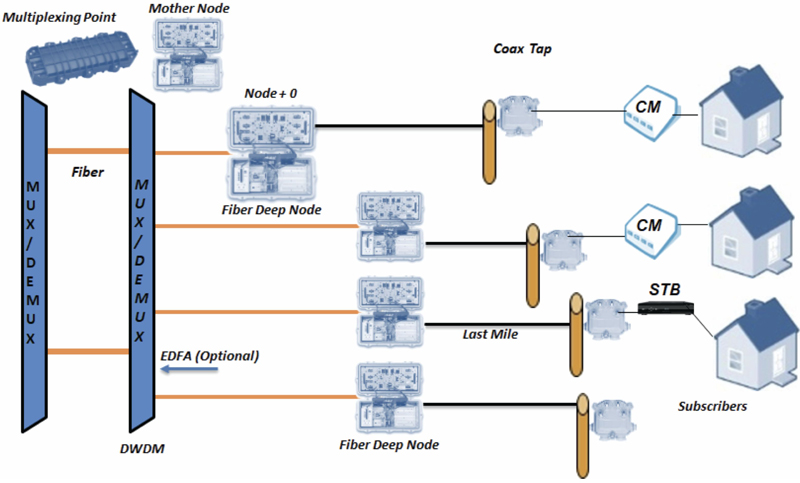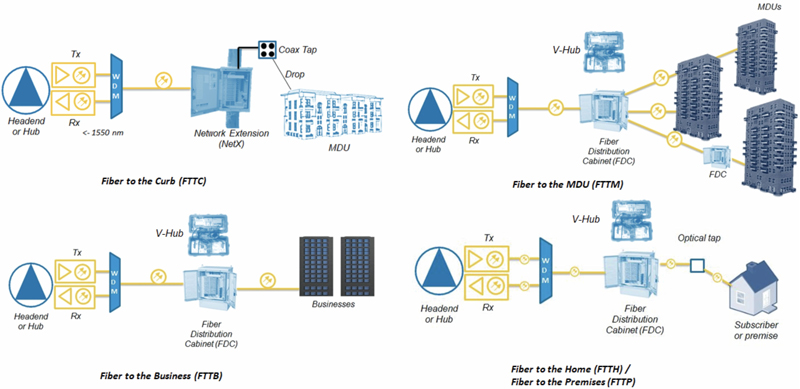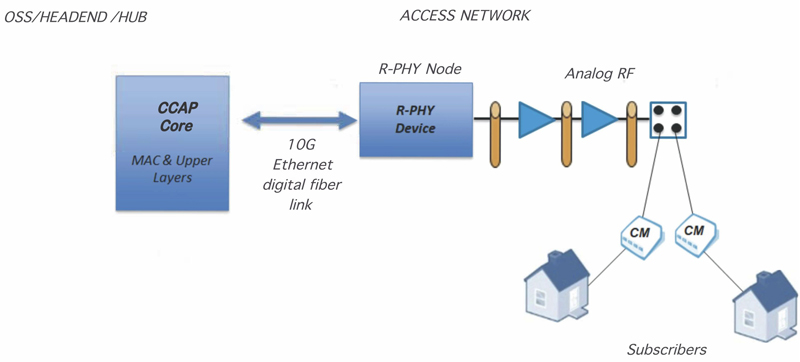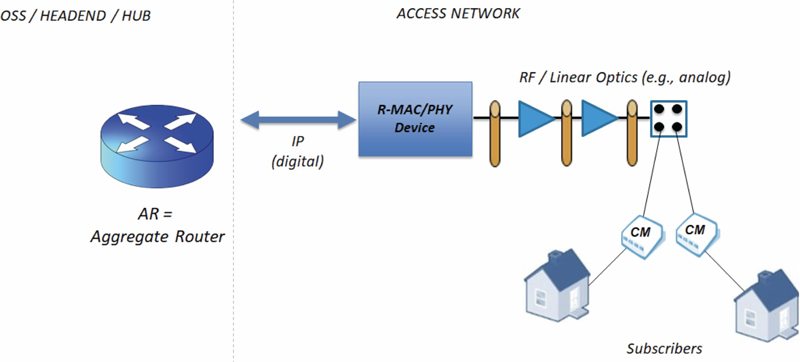Contrasting the New Fiber Enhanced Access Network Architectures
By Steven Harris
The days of the analog tree-and-branch coaxial architectures are long gone for operators! Operators have augmented these architectures in decades past with fiber optics to advance services, reduce noise, improve quality, and prepare for digital networks. This popular architecture is known as hybrid fiber/coax (HFC), where operators replaced the coax trunk portion of the distribution network with fiber cabling and an optical node. HFC has supported more than 172 million subscribers worldwide!
Over the last 20 years operators have steadily evolved and improved the HFC network, with many of the enhancements to support varying degrees of high-speed data (HSD), voice over IP (VoIP) calling and digital IP based video, along with improved reliability. In the late 1990s and early 2000s, many HFC networks supported bandwidth of less than 860 MHz and households passed (HHP) as high as 1,000 or more subscribers per optical node. During this time HFC RF signaling may have supported only a single 256 quadrature amplitude modulation (QAM) channel in the downstream (DS) and a single quadrature phase shift keying (QPSK) channel in the upstream (US) for HSD, along with many National Television System Committee (NTSC) and QAM channels for video. In the next decade, operators have been upgrading these HFC networks to offer more bandwidth (e.g., 860 MHz or 1002 MHz), fewer HHP (e.g., 500), and adding multiple RF channels for HSD and digital video. Around 2012, operators started using DOCSIS 3.0’s channel bonding (e.g., 32 x 6 MHz), and more recently DOCSIS 3.1’s wider channels (up to 192 MHz) for HSD, improving the bits per second per hertz (Hz). In addition, operators have been deploying healthier versions MPEG compression for digital video. The trend will be clear, more bits per second per Hz will be desirable in the access network of the future, requiring operators to continue to leverage fiber optics technology.

The access network evolution is happening today with the deployment of new next generation architectures as subscribers are demanding greater reliably, better video, and faster HSD. These new networks are leveraging architectures called fiber deep (FD), fiber to the x (FTTx), x passive optical networks (xPON), and distributed access architectures (DAA). The remainder of the article will compare these new architectures. Also, to note, HFC will not be replaced by these architectures immediately but will be designed to operate in conjunction with these new architectures.
FD is different from the traditional HFC network in that it does not contain active devices in the last mile, or also known by many cable folks as node + 0. FD is pushing optical fiber along with a FD node within a few thousand or hundred feet from the subscriber premises, replacing the coax cabling along the way. FD uses an access network multiplexing point to recover multiplexed optical signals from the headend to feed FD nodes in the network, then multiplexing is also used from the FD node in the upstream towards the headend. FD also allows for operators to improve the upstream bandwidth by expanding beyond the traditional 42 MHz limits. Finally, FD provides a superior network for a full duplex DOCSIS (FDX) deployment.
The Fiber Deep Access Network:The next access network that is currently in deployment is the FTTx/xPON architecture. The FTTx network uses optical cabling in place of the traditional coaxial cabling found in the HFC network. When the HFC coax cabling is replaced, the HFC is transformed into an optical distribution network (ODN). In a centralized ODN for example, operators will use optical splitters (e.g., 32 way) housed in a fiber distribution cabinet (FDC) to share an optical signal with multiple FTTx/xPN subscribers. In addition, there are unique topologies for FTTx known as fiber to the premises or business (FTTP/FTTB). For FTTP, fiber is routed from an optical tap in the ODN to a termination point at the subscriber’s premises. An optical tap was chosen to resemble the distribution taps used in the HFC coax feeder while keeping losses at a much-improved level than a coax plant. There are also other forms of FTTx such as fiber to the curb (FTTC), where fiber is terminated at a telecommunication pole location, then coax may be leveraged to connect to the subscriber’s premises.

FTTH, FTTP, FTTC, FTTB and FTTM Topologies:Besides the FTTx topologies mentioned, operators use special FTTx technologies and protocols over the ODN. The three main technologies used are RF over glass (RFoG), Ethernet passive optical network (EPON), and gigabit passive optical network (GPON). The industry uses xPON to denote the EPON and GPON architectures. When RFoG is used, the data packets are sent over the ODN like in HFC, however, xPON employs Ethernet frames but may still be provisioned with a DOCSIS back office. With each of these FTTx options, operators may reap the benefits of a greener network with improved reliability.

The final network access architecture that is gaining traction is known as DAA. In DAA, operators are moving physical (Layer 1) and data-link (Layer 2) access hardware into the HFC access network. Remote physical layer, or R-PHY, is one of the popular options for DAA, upgrading the HFC optical node by adding a R-PHY device (RPD), and providing digital optics and pseudowire logic. The RPD allows operators to separate the CCAP core from the physical layer electronics. The RPD can be located in a R-PHY shelf or R-PHY node.
R-MAC/PHY Architecture:Another option for DAA is remote media access control (MAC) / PHY, or R-MAC/PHY. The R-MAC/PHY option permits operators to achieve a true IP connection into the access network by moving Layer 2 functionally into the access network. A final option for DAA, is split-MAC where some of the Layer 2 intelligence resides at the headend as well as the access network. The goal for a DAA is network function virtualization (NFV) and software defined networking (SDN), providing operators with many options for rapid delivery of next generation networks.
To be successful in the future of telecommunications it will be imperative to comprehend all the variations in our access networks for connecting our subscribers. As mentioned, these options are being deployed for many reasons such as more bits per second per Hz (that is, better spectral efficiency), higher video resolutions (e.g., 4K), improved network performance (e.g., FDX), greener networks, and improved customer experiences. Keep in mind, operators also have the ability to combine the above-mentioned architectures, for example deploying a FD network with R-PHY for added benefits and flexibilities.

This article was written to get you started on your journey to learn about the latest fiber optic technologies, protocols, and architectures leveraged in our networks. Leveraging your SCTE·ISBE membership will allow you to consume many of the great resources we have to offer in this area.
 Steven Harris
Steven Harris
Senior Director, Advanced Network Technology and Instruction, Learning and Development, SCTE•ISBE
Steve Harris is the senior director of advanced network technology and instruction at SCTE•ISBE. He is a respected international telecommunications subject matter expert, sought-after presenter and principal instructor. He is responsible for the tremendous growth of SCTE•ISBE training programs and certifications for over 100,000 telecommunications professionals. He also has responsibility for the client partnership in the SCTE•ISBE Corporate Alliance Program for cable operators and vendors.



